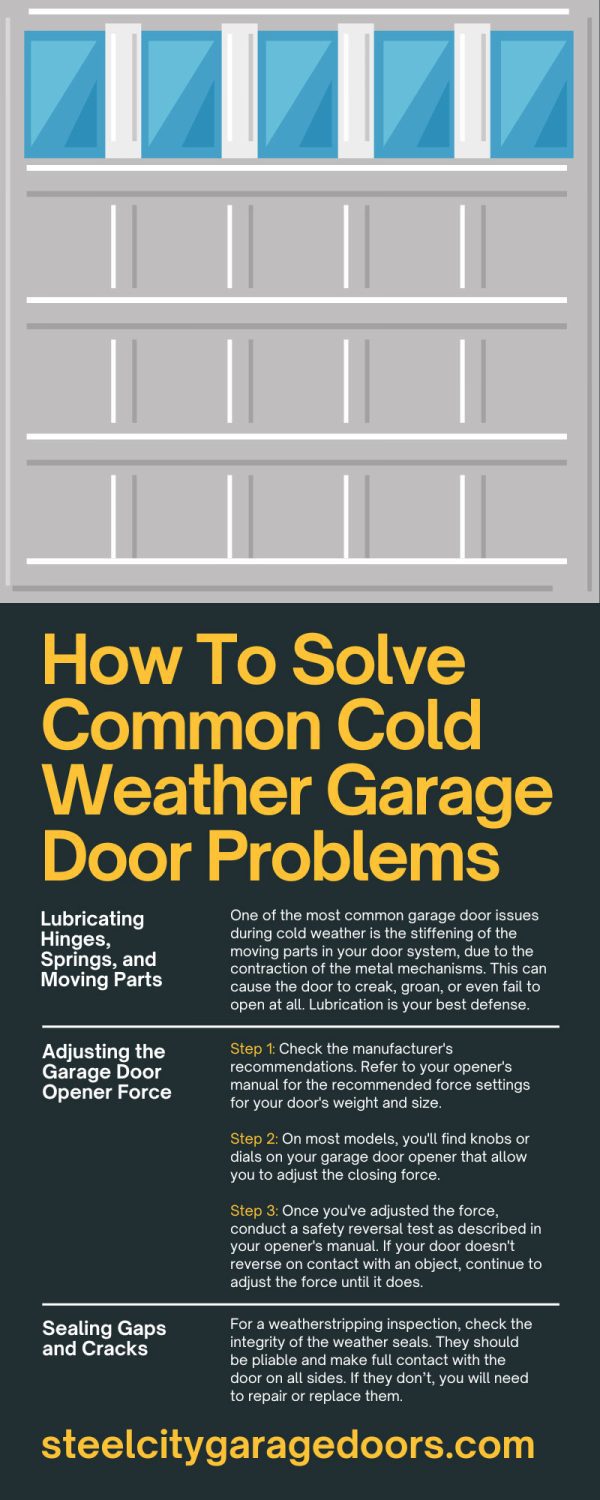Winter is particularly harsh on garage doors, especially in regions with extremely cold temperatures and significant snowfall, like Pittsburgh. Cold weather can cause mechanical components to stiffen or freeze, leading to various issues that can compromise the security, functionality, and longevity of your garage door.
As a homeowner, understanding how to diagnose and rectify these problems is crucial, especially when the weather is at its worst. We’ve put together a comprehensive guide with clear instructions on how to solve common cold weather garage door problems so you can properly care for your door and its components. But if you need professional assistance after taking the following steps, you can always call us at Steel City Garage Doors.
Lubricating Hinges, Springs, and Moving Parts
One of the most common garage door issues during cold weather is the stiffening of the moving parts in your door system, due to the contraction of the metal mechanisms. This can cause the door to creak, groan, or even fail to open at all. Lubrication is your best defense.
Selecting the Right Lubricant
It is essential to use a silicone-based or lithium-based lubricant designed for garage door use. Avoid using oil-based or petroleum-based products that can attract dust and grime and become gummy in cold weather.
Application Process
Step 1: Before you begin, disconnect the power from your garage door opener to avoid any accidental activations.
Step 2: Apply the lubricant to the springs and all the hinges, moving the door to provide access to all parts. You may need to support the door in the open position with vice grips or another device to prevent it from falling during this process.
Step 3: Apply the lubricant to the rollers, but keep the tracks dry to prevent them from becoming too slick and causing the door to slip.
Step 4: Manually open and close the door a few times to work in the lubricant, then reconnect the opener to see if the issue is resolved.
Regular lubrication throughout the winter is a good proactive measure to prevent your door from malfunctioning.
Adjusting the Garage Door Opener Force
Extreme cold can increase the resistance on your garage door opener, requiring more force to operate the door. If the opener is set too lightly for winter conditions, it may cease to function correctly.
Setting the Force
Step 1: Check the manufacturer’s recommendations. Refer to your opener’s manual for the recommended force settings for your door’s weight and size.
Step 2:. On most models, you’ll find knobs or dials on your garage door opener that allow you to adjust the closing force.
Step 3: Once you’ve adjusted the force, conduct a safety reversal test as described in your opener’s manual. If your door doesn’t reverse on contact with an object, continue to adjust the force until it does.
Make force adjustments with caution, as setting the force too high can create a safety hazard and potentially damage the door. If you’re unsure about this step, contact Steel City Garage Doors for help.
Sealing Gaps and Cracks
Cold drafts and snow and moisture intrusion can lead to a variety of garage door problems, including freezing components and damage of stored items.
Identifying Problem Areas
To identify any problem areas around your garage door, start with a visual inspection. Look for cracks and gaps around the door and frame, as well as any in the weatherstripping.
For a weatherstripping inspection, check the integrity of the weather seals. They should be pliable and make full contact with the door on all sides. If they don’t, you will need to repair or replace them.
Repair and Replacement
There are several options for repair and replacement of problem areas around your garage door. One popular option is sealing with caulk. Use high-quality exterior caulk to seal any gaps and cracks around the door frame, especially near the floor where snow may intrude.
Adjusting the Door Limit Settings
As temperatures drop, the metal in garage door components can contract. This can cause the door to come down harder and faster than necessary, which is dangerous.
Resetting the Limit Settings
Step 1: Locate your garage door opener and remove the cover to access the limit adjustment screws.
Step 2: Considering the current weather and door position, you might need to adjust the open and close limits to a lower distance to slow the door’s operation.
Step 3: Make the necessary adjustments, then test the door to ensure it closes slowly and makes a solid seal without slamming shut.
Properly setting the limits for colder weather is essential to protect your door and opener system, as well as the contents of your garage.
Dealing with Frozen Garage Doors
One of the most frustrating issues you might face in cold weather is a garage door that is frozen shut. Several factors can cause this, such as a seal that’s too tight or moisture that has seeped into components and then frozen.
Safely Opening a Frozen Door
Step 1: Use a heat gun, hairdryer, or hot water to gently thaw any ice that’s preventing door movement.
Step 2: Wipe down the seals and door components with a clean, dry cloth to remove any remaining moisture.
Step 3: Once the door is free, apply a silicone-based lubricant to the hinges and moving parts to prevent future freezing.
Preventing moisture infiltration with a good seal and regularly cleaning off snow and ice from your door can help you avoid this problem altogether.
Knowing how to solve common cold weather garage door problems can save you time, hassle, and potential repair costs. However, sometimes certain problems require specialized attention and repair that only the experts can supply. If you’re unable to try the above tips or if you’ve already tried these tactics without success, then you need professional help. Steel City Garage Doors is proud to be here for you.
We offer emergency garage repair when you need assistance. Emergency repairs are available 24/7 in the Pittsburgh area, including Monroeville, Cranberry, Gibsonia, and other nearby locations.




